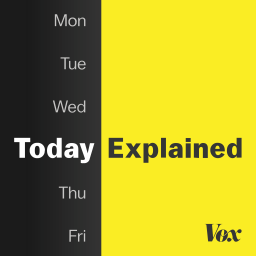
by Dr. Richard Lai DPT L.Ac
Isn't learning Acupuncture at school confusing? And isn't it hard to find time after class to really get into the material? Here's where I come in! I'm Dr. Richard Lai, Doctor of PT and L.Ac; I'm all about clinical reasoning and rationale when it comes to treating my patients, and through this podcast I bring you educational content that will help you towards clinical success in the healthcare world. Whether you're in school and studying for the boards or out there in the real world, I review theory, points, business and more!
Language
🇺🇲
Publishing Since
1/21/2020
Email Addresses
1 available
Phone Numbers
0 available

April 18, 2025
<p><strong>Episode Description:</strong><br>In this episode, Dr. Richard Lai dives deep into a must-know topic for every acupuncture student and practitioner: how to differentiate between Wind Cold and Wind Heat patterns in Traditional Chinese Medicine (TCM). If you've ever found these patterns confusing—especially when prepping for board exams—you're not alone! Dr. Lai walks listeners through two exam-style case studies, highlighting the subtle but critical differences between the two. You’ll learn which clinical features, tongue and pulse signs, and classic symptoms set Wind Cold apart from Wind Heat—tips that will help you ace your exams and get better results in clinic.</p><p><strong>Show Notes:</strong></p><ul><li><p><strong>Introduction to the Episode</strong></p><ul><li><p>Dr. Lai shares his mission to make TCM concepts easier to understand and retain for students and practitioners.</p></li><li><p>Quick reminder to sign up for his "Quick Win" newsletter for weekly board exam questions and explanations in under five minutes.</p></li><li><p><a href="http://www.studyacuwithme.com/quickwin" target="_blank" rel="noopener noreferrer">Sign up here</a></p></li></ul></li><li><p><strong>Why Wind Cold vs Wind Heat Matters</strong></p><ul><li><p>This differentiation is a frequent board exam topic and an everyday clinical challenge.</p></li><li><p>Dr. Lai explains that though symptoms can overlap, recognizing key differences is essential.</p></li></ul></li><li><p><strong>Case Study 1: Wind Heat Pattern</strong></p><ul><li><p>25-year-old grad student, Tracy: mild sore throat, mild fever, nasal congestion, slight red tongue tip, thin yellow coating, floating and slightly rapid pulse, spontaneous sweating, scratchy throat.</p></li><li><p>Classic Wind Heat symptoms identified: yellow tongue coat, red tongue tip, fever, sore throat, floating-rapid pulse and sweating.</p></li><li><p>Dr. Lai breaks down the pathophysiology—how Wind Heat impairs the lung’s descending and dispersing function, resulting in upper body symptoms.</p></li></ul></li><li><p><strong>Case Study 2: Wind Cold Pattern</strong></p><ul><li><p>37-year-old PT, Raffi: body aches, runny nose, congestion, chills, cannot get warm, mild scratchy throat, no sweat, no thirst, pale tongue with thin white coat, floating and tight pulse.</p></li><li><p>Hallmarks of Wind Cold: tight pulse, strong chills, no sweating, pale tongue, thin white coating.</p></li><li><p>Discussion on how these findings help rule out interior cold and yang deficiency.</p></li><li><p>Dr. Lai emphasizes the importance of tongue and pulse in differentiating cases on the exam.</p></li></ul></li><li><p><strong>Quick Review & Tips</strong></p><ul><li><p>Key symptoms to distinguish Wind Heat vs Wind Cold</p></li><li><p>The importance of tongue color/coat, pulse quality, and specific symptom presentations.</p></li><li><p>How exams may offer tricky answer choices—look for the “most correct” answer based on the case details.</p></li></ul></li><li><p><strong>Stay Connected</strong></p><ul><li><p>Sign up for Dr. Lai’s Quick Win Newsletter for more board exam questions and explanations.</p></li><li><p><a href="http://www.studyacuwithme.com/quickwin" target="_blank" rel="noopener noreferrer">www.studyacuwithme.com/quickwin</a></p></li></ul></li></ul><p><strong>Resources Mentioned:</strong></p><ul><li><p><a href="http://www.studyacuwithme.com" target="_blank" rel="noopener noreferrer">Study Acupuncture with Me Website</a></p></li><li><p><a href="http://www.studyacuwithme.com/quickwin" target="_blank" rel="noopener noreferrer">Quick Win Newsletter</a></p></li></ul><p><strong>Thank you for listening!</strong><br>If you enjoyed this episode or found it helpful, please subscribe, share, and leave a review. Until next time—good luck with your studies and clinic, and happy studying!</p><p><br></p>

April 11, 2025
<p><strong>Episode Summary:</strong></p><p>Welcome to another insightful episode of "Study Acupuncture with Me". In this episode, we're diving into the intricacies of Heart Yin Deficiency, a common pattern in both clinical practice and board exams. We're going to talk about Heart Yin Deficiency in terms of Pattern identification and potential causes</p><p><strong>Key Topics Discussed:</strong></p><ol><li><p><strong>Introduction to Heart Yin Deficiency:</strong></p><ul><li><p>Overview of heart functions in traditional Chinese medicine, focusing on the heart's role in governing blood and housing the Shen (spirit).</p></li></ul></li><li><p><strong>Heart Yin vs. Heart Yang:</strong></p><ul><li><p>Explanation of how Heart Yin and Yang are complementary forces, with Yin nourishing and anchoring the heart, and Yang propelling physiological activity.</p></li></ul></li><li><p><strong>Signs and Symptoms:</strong></p><ul><li><p>Common manifestations include palpitations, insomnia, anxiety, and dry mouth, with specific signs such as a tongue without coating and a floating, empty pulse indicating Yin deficiency.</p></li></ul></li><li><p><strong>Causes:</strong></p><ul><li><p>Discusses stress, overwork, and external factors like heat as primary causes of Heart Yin Deficiency.</p></li></ul></li><li><p><strong>Differential Diagnosis:</strong></p><ul><li><p>Differentiating insomnia from Heart Yin Deficiency and Heart Blood Deficiency based on sleep patterns.</p></li></ul></li><li><p><strong>Recommendations:</strong></p><ul><li><p>Importance of consulting an acupuncturist for personalized treatment, with points like Ren 4, Ren 14, and Spleen 6 highlighted for nourishing heart Yin.</p></li></ul></li></ol><p><strong>Additional Resources:</strong></p><ul><li><p>Sign up for my weekly newsletter featuring a quick win with one multiple-choice practice question and explanation: <a href="www.studyacuwithme.com/quickwin" target="_blank" rel="noopener noreferer">www.studyacuwithme.com/quickwin</a></p></li></ul><p>Feel free to reach out with feedback or questions about the topics discussed in this episode. And don't forget to subscribe to our podcast and join the conversation in the comments below! Happy studying!</p><p><br></p>

March 23, 2025
<p> In this episode, let's takes a deep dive into the often-confusing topic of Lung Yin Deficiency versus Lung Dryness. These two patterns might sound similar, but understanding their nuances is crucial for effective acupuncture treatment and accurate diagnosis.</p><p><strong>Episode Highlights:</strong></p><ul><li><p><strong>Introduction to Lung Patterns:</strong> Dr. Lai discusses the importance of differentiating between Lung Yin Deficiency and Lung Dryness, especially for board exams and clinical practice.</p></li><li><p><strong>The Lungs – A Delicate Organ:</strong> Learn about why the lungs are considered a delicate organ in Traditional Chinese Medicine and how external factors influence them.</p></li><li><p><strong>Understanding Lung Dryness:</strong> Discover the causes and symptoms associated with lung dryness, from environmental factors like dry climates and air-conditioned spaces to lifestyle influences such as smoking and hydration.</p></li><li><p><strong>Lung Yin Deficiency Explored:</strong> Dr. Lai explains the manifestations of lung yin deficiency and how they differ from lung dryness, including the role of empty heat signs.</p></li><li><p><strong>Differential Diagnosis Tips:</strong> Get practical advice on differentiating between these two patterns using clinical observations and diagnostic techniques.</p></li><li><p><strong>Acupuncture Treatment Points:</strong> Dr. Lai shares effective acupuncture points for treating both lung dryness and lung yin deficiency, with special focus on yin-nourishing points like Spleen 6 and Lung 9.</p></li><li><p><strong>Practical Tips for Lung Health:</strong> Enhance your lung health with simple, everyday tips on hydration, diet, posture, and environment management that Dr. Lai provides for both acupuncture practitioners and the general public.</p></li><li><p><strong>Engage and Share:</strong> Join the conversation! Dr. Lai invites listeners to share their experiences and tips in the comments, and to help spread the knowledge by sharing this episode with fellow students and practitioners.</p></li></ul><p>Tune into this episode to deepen your understanding and appreciation for the complexities of lung health within acupuncture practice. Don't forget to subscribe for more enriching acupuncture content, and if you’re enjoying the podcast, please leave a review on Apple Podcasts to help us reach more listeners!</p><p>Happy studying, and until next time, take care of your lungs! 🌿</p>

Unknown author

Dr. Daoshing Ni, Dr. James Skoien

Clara Cohen

Michael Max

Dr. Mark Hyman

Jason Bateman, Sean Hayes, Will Arnett

The New York Times

Sue Meyer

Vox
Pod Engine is not affiliated with, endorsed by, or officially connected with any of the podcasts displayed on this platform. We operate independently as a podcast discovery and analytics service.
All podcast artwork, thumbnails, and content displayed on this page are the property of their respective owners and are protected by applicable copyright laws. This includes, but is not limited to, podcast cover art, episode artwork, show descriptions, episode titles, transcripts, audio snippets, and any other content originating from the podcast creators or their licensors.
We display this content under fair use principles and/or implied license for the purpose of podcast discovery, information, and commentary. We make no claim of ownership over any podcast content, artwork, or related materials shown on this platform. All trademarks, service marks, and trade names are the property of their respective owners.
While we strive to ensure all content usage is properly authorized, if you are a rights holder and believe your content is being used inappropriately or without proper authorization, please contact us immediately at [email protected] for prompt review and appropriate action, which may include content removal or proper attribution.
By accessing and using this platform, you acknowledge and agree to respect all applicable copyright laws and intellectual property rights of content owners. Any unauthorized reproduction, distribution, or commercial use of the content displayed on this platform is strictly prohibited.